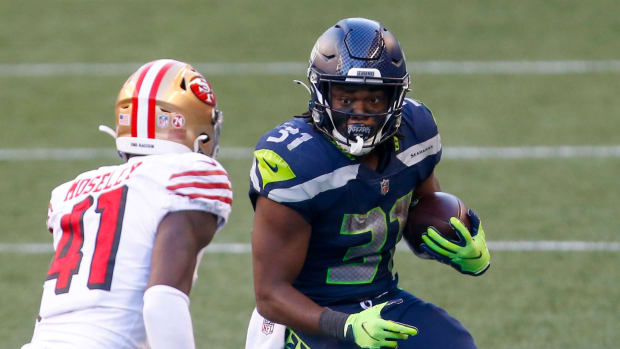How Seahawks Stifled Rams' Offense, Can Repeat Performance in Wild Card Rematch
In Week 16, the Seahawks’ defense thrived against the Los Angeles Rams. The NFC West-clinching win proved that the defensive success in the second half of the season wasn’t solely a mirage of poor opponents faced. Can the Seahawks repeat it in the Wild Card round, the third team these two will meet in this campaign?
It’s often felt like Sean McVay has managed to stay ahead of Pete Carroll. As hard as the Seahawks have tried to scheme the Rams’ attack into struggles, Los Angeles has repeatedly carved open Seattle. The Week 16 Seahawks victory was so joyous and momentous because the Seahawks totally stifled McVay. Goff completed 24 of 43 pass attempts for 234 yards, no touchdowns, and one interception.
What was particularly rewarding about the Carroll-Ken Norton Jr defensive display was their ability to remove McVay's core concepts. These staples have persistently wrecked Seattle, while pesky wrinkles of evolution have been added over time. However, in Week 16, the play action bootlegs, wide zone runs, and jet sweeps did not hit. The Rams are a series-based offense in many ways, looking to counter jab. Yet in the most recent encounter, McVay was unable to even tickle the Seahawks, left sagging on the ropes.
The Rams called 15 play action plays and averaged just 2.7 yards on these plays. Goff attempted 10 passes, completing four of them for 34 yards. Five fell incomplete and one was intercepted by Quandre Diggs. On the five remaining plays, Goff scrambled four times for 13 yards and was sacked once.
The key for Seattle was simplicity. Pete Carroll admitted in his 710 ESPN Seattle radio hit the Monday afterwards that he had “tried too hard,” in previous encounters with the Rams. The Seahawks spent time in their new base defensive front of “bear” spacing, where they cover up the interior three offensive linemen with defensive linemen while having K.J. Wright and the LEO as wide backstops either side - called “stick," “falcon," and “rocky” in recent years. They also ran basic coverages, primarily Cover 2 and Cover 3 Sky.
This gave them the spacing to remove the Rams’ bootleg options. They had low conflict overhangs to either side of the formation, ready to get right in the face of Goff and limit the scramble potential. Meanwhile, downfield, they were able to get multiple layers to the flood patterns of Los Angeles’ route combinations. Factoring in the threat of the quarterback keeper, the Rams essentially have five threats to one side of the field. Yet Seattle was able to limit the gains and contain these dangerous elements.
Check out my twitter thread for in-depth explanations of the system and video.
The next step for Seattle's defense versus Los Angeles is an interesting one. The Seahawks have rediscovered their identity and this has been the key to their late season performances. Apart from switching up the fancier, passing down calls, I’m not sure what Seattle can do in a neutral script apart from execute to an even higher standard.
Last week, Kyle Shanahan managed to cause issues for the Seahawks’ Cover 3 sky via a crack back toss run that pinned K.J. Wright inside, out-leveraged the spill/run thru linebacker, and then ran right at the bailing cornerback who needed to crack-replace quicker. The Seahawks adjusted by running Cover 3 buzz, putting Jamal Adams down to the same side as Wright and letting him demand the opportunity to attack the crack back and it worked. This is one area of evolution we may see.
The nervy aspect of Saturday is the possibility of John Wolford being at quarterback. That may read like a ridiculous sentence. However, Wolford’s athletic ability means -despite the unconflicted defenders on the edge ready to play him and increased Seattle range - certain bootleg runs turn into first down yardage.
Wolford, formerly with the Arizona Hotshots of the defunct AAF, tested somewhat athletically at his 2018 pro day, running a 4.77-second 40-yard dash and 6.78-second 3-cone. The threat of him throwing the football well is less real, and Seattle will be able to attack him by vacating their coverage sooner.
In Week 17 versus the Cardinals, McVay had Wolford operate mainly from the shotgun in order to let him vision the field and take off quickly if possible - under center bootleg trust may be out of the picture altogether. The Rams will need to run the ball A LOT; this plays into the stop-the-run-first mindset of the Seahawks.
Goff has been seen throwing at practice, yet his status remains "uncertain." It would be a remarkable recovery from thumb surgery for the 2016 first overall pick. In the week leading up to this game, McVay has tried his best gamesmanship, reiterating throughout that he doesn’t know who is starting at quarterback. Goff looked lost versus Seattle’s simplicity last time round - is McVay’s only hope mind games?
Prior to the Week 16 defeat, Goff had been a consistently high quality performer against nobody OTHER than the Seahawks. Seattle’s 2020 defense has been built and schemed to defeat opponents in the NFC West. They achieved that in regular action. Expect it to happen in the playoffs for the final time this season.




